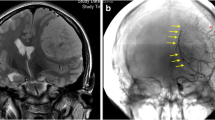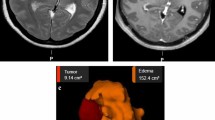Abstract
Meningiomas is a tumor of the meninges and is among the most common intracranial neoplasms in adults, accounting for over a third of all primary brain tumors in the United States. Meningiomas can be associated with peritumoral brain edema (PTBE) which if not managed appropriately can lead to poor clinical outcomes. In this review, we summarize the relevant pathophysiology, predictors, and principles for treatment of PTBE. The results of various case-reports and case-series have found that meningioma-associated PTBE have patterns in age, tumor size, and hormone receptor positivity. Our study describes how increased age, increased tumor size, tumor location in the middle fossa, and positive expression of hormone receptors, VEGF, and MMP-9 can all be predictors for worse clinical outcomes. We also characterize treatment options for PTBE such as glucocorticoids and VEGF inhibitors along with the ongoing clinical trials attempting to alleviate PTBE in meningioma cases. The trends summarized in this review can be used to better predict the behavior of meningioma-associated PTBE and establish prognosis models to identify at risk patients.


Similar content being viewed by others
References
Alruwaili AA, De Jesus O. Meningioma. Stat Pearls [Internet]. Available from https://www.ncbi.nlm.nih.gov/books/NBK560538/.
Ogasawara C, Philbrick BD, Cory Adamson D. Meningioma: a review of epidemiology, pathology, diagnosis, treatment, and future directions. Biomedicines [Internet]. Multidisciplinary Digital Publishing Institute (MDPI); 2021 [cited 2022 Oct 25];9. Available from https://www.ncbi.nlm.nih.gov/pmc/articles/PMC8004084/.
Dolecek TA, Van Meter DE, Thakkar JP, Liu M, Al-Qaisi A, Villano JL. Epidemiology of meningiomas post public law 107–206—the benign brain tumor cancer registries act. Cancer. 2015;121:2400.
Buerki RA, Horbinski CM, Kruser T, Horowitz PM, James CD, Lukas RV. An overview of meningiomas. Future Oncol. 2018;14:2161.
Larjavaara S, Haapasalo H, Sankila R, Helén P, Auvinen A. Is the incidence of meningiomas underestimated? A regional survey. Br J Cancer. 2008;99:182–4.
Lin D, Lin J, Deng X, Li W, Li D, Yin B, et al. Trends in intracranial meningioma incidence in the United States, 2004–2015. Cancer Med. 2019;8:6458.
Hou J, Kshettry VR, Selman WR, Bambakidis NC. Peritumoral brain edema in intracranial meningiomas: the emergence of vascular endothelial growth factor-directed therapy. Neurosurg Focus. 2013;35:E2.
Marosi C, Hassler M, Roessler K, Reni M, Sant M, Mazza E, et al. Meningioma. Crit Rev Oncol Hematol. 2008;67:153–71.
Shin C, Kim JM, Cheong JH, Ryu JI, Won YD, Ko Y, et al. Association between tumor size and peritumoral brain edema in patients with convexity and parasagittal meningiomas. PLoS ONE. 2021;16: e0252945.
Toh CH, Siow TY, Castillo M. Peritumoral brain edema in meningiomas may be related to glymphatic dysfunction. Front Neurosci. 2021;15: 674898.
Michinaga S, Koyama Y. Pathogenesis of brain edema and investigation into anti-edema drugs. Int J Mol Sci. 2015;16:9949–75.
Nehring SM, Tadi P, Tenny S. Cerebral edema. StatPearls. Treasure Island, FL: StatPearls Publishing; 2021.
Belov Kirdajova D, Kriska J, Tureckova J, Anderova M. Ischemia-triggered glutamate excitotoxicity from the perspective of glial cells. Front Cell Neurosci. 2020;14:51.
Jha SK. Cerebral edema and its management. Armed Forces Med J India. 2003;59:326–31.
Daneman R, Prat A. The blood–brain barrier. Cold Spring Harb Perspect Biol [Internet]. Cold Spring Harbor Laboratory Press; 2015 [cited 2022 Oct 25];7. Available from https://www.ncbi.nlm.nih.gov/pmc/articles/PMC4292164/.
Higaki F, Inoue S, Oda W, Matsusue E, Hiraki T. MRI multiparametric scoring system for pial blood supply of intracranial meningiomas. Acta Radiol Open [Internet]. SAGE Publications; 2022 [cited 2022 Oct 25];11. Available from https://www.ncbi.nlm.nih.gov/pmc/articles/PMC9003652/.
Tamiya T, Ono Y, Matsumoto K, Ohmoto T. Peritumoral brain edema in intracranial meningiomas: effects of radiological and histological factors. Neurosurgery [Internet]. Neurosurgery; 2001 [cited 2022 Oct 25];49. Available from https://pubmed.ncbi.nlm.nih.gov/11846896/.
Simis A, Pires de Aguiar PH, Leite CC, Santana PA Jr, Rosemberg S, Teixeira MJ. Peritumoral brain edema in benign meningiomas: correlation with clinical, radiologic, and surgical factors and possible role on recurrence. Surg Neurol. 2008;70:471–7 (discussion 477).
Liyanage UA, Mathangasinghe Y, Wijerathne PK, Vithoosan S, Pallewatte A. Location and diameter of intracranial meningioma as predictors of peritumoral brain oedema and mass effect. J Med Imaging Radiat Sci. 2020;51:411–6.
Kim B-W, Kim M-S, Kim S-W, Chang C-H, Kim O-L. Peritumoral brain edema in meningiomas: correlation of radiologic and pathologic features. J Korean Neurosurg Soc. 2011;49:26–30.
Bitzer M, Wöckel L, Luft AR, Wakhloo AK, Petersen D, Opitz H, et al. The importance of pial blood supply to the development of peritumoral brain edema in meningiomas. J Neurosurg. 1997;87:368–73.
Blitshteyn S, Crook JE, Jaeckle KA. Is there an association between meningioma and hormone replacement therapy? J Clin Oncol. 2022. https://doi.org/10.1200/JCO.2007.14.2133.
Maiuri F, Montagnani S, Iaconetta G, Gallicchio B, Bernardo A, Signorelli F. Correlation between sex hormone receptors and peritumoral edema in intracranial meningiomas. J Neurosurg Sci. 1994;38:29–33.
Meningiomas and Brain Edema [Internet]. Clinical Gate. 2015 [cited 2022 Oct 25]. Available from https://clinicalgate.com/meningiomas-and-brain-edema/.
Ramirez Grueso R, Barcenas L, Arias JA, Colegial C, Avendaño CL Sr, Chaves J, et al. Characterization of progesterone receptor expression in intracranial meningiomas of patients treated in a high-complexity hospital in Bogota, Colombia. Cureus. 2020;12: e12355.
Loewenstern J, Aggarwal A, Pain M, Barthélemy E, Costa A, Bederson J, et al. Peritumoral edema relative to meningioma size predicts functional outcomes after resection in older patients. Oper Neurosurg (Hagerstown). 2019;16:281–91.
Schwartz C, Rautalin I, Niemelä M, Korja M. Symptomatic peritumoral edema is associated with surgical outcome: a consecutive series of 72 supratentorial meningioma patients ≥ 80 years of age. J Neurooncol. 2020;148:109–16.
Gurkanlar D, Er U, Sanlı M, Özkan M, Sekerci Z. Peritumoral brain edema in intracranial meningiomas. J Clin Neurosci Elsevier. 2005;12:750–3.
Otsuka S, Tamiya T, Ono Y, Michiue H, Kurozumi K, Daido S, et al. The relationship between peritumoral brain edema and the expression of vascular endothelial growth factor and its receptors in intracranial meningiomas. J Neurooncol. 2004;70:349–57.
Reszec J, Hermanowicz A, Rutkowski R, Turek G, Mariak Z, Chyczewski L. Expression of MMP-9 and VEGF in meningiomas and their correlation with peritumoral brain edema. Biomed Res Int. 2015;2015: 646853.
Yoshioka H, Hama S, Taniguchi E, Sugiyama K, Arita K, Kurisu K. Peritumoral brain edema associated with meningioma: influence of vascular endothelial growth factor expression and vascular blood supply. Cancer [Internet]. Cancer; 1999 [cited 2022 Oct 25];85. Available from https://pubmed.ncbi.nlm.nih.gov/10091773/.
Pei J, Jung S, Jin S-G, Moon K-S, Wen M, Li S-Y, et al. Possible role of matrix metalloproteinases (MMPs) in hyperostosis of intracranial meningiomas. Acta Neurochir. 2012;154:611–20.
Jung S, Moon K-S, Kim S-T, Ryu H-H, Lee Y-H, Jeong Y-I, et al. Increased expression of intracystic matrix metalloproteinases in brain tumors: relationship to the pathogenesis of brain tumor-associated cysts and peritumoral edema. J Clin Neurosci. 2007;14:1192–8.
Paek SH, Kim C-Y, Kim YY, Park IA, Kim MS, Kim DG, et al. Correlation of clinical and biological parameters with peritumoral edema in meningioma. J Neurooncol. 2002;60:235–45.
Park KJ, Kang SH, Chae YS, Yu MO, Cho TH, Suh JK, et al. Influence of interleukin-6 on the development of peritumoral brain edema in meningiomas. J Neurosurg [Internet]. J Neurosurg; 2010 [cited 2022 Oct 25];112. Available from https://pubmed.ncbi.nlm.nih.gov/19445568/.
Gabay C. Interleukin-6 and chronic inflammation. Arthritis Res Ther BioMed Central. 2006;8:S3.
Polyzoidis S, Koletsa T, Panagiotidou S, Ashkan K, Theoharides TC. Mast cells in meningiomas and brain inflammation. J Neuroinflammation. 2015;12:170.
Reszec J, Hermanowicz A, Rutkowski R, Bernaczyk P, Mariak Z, Chyczewski L. Evaluation of mast cells and hypoxia inducible factor-1 expression in meningiomas of various grades in correlation with peritumoral brain edema. J Neurooncol. 2013;115:119.
Osawa T, Tosaka M, Nagaishi M, Yoshimoto Y. Factors affecting peritumoral brain edema in meningioma: special histological subtypes with prominently extensive edema. J Neurooncol. 2013;111:49–57.
Tanaka M, Imhof HG, Schucknecht B, Kollias S, Yonekawa Y, Valavanis A. Correlation between the efferent venous drainage of the tumor and peritumoral edema in intracranial meningiomas: superselective angiographic analysis of 25 cases. J Neurosurg. 2006;104:382–8.
Murata Y, Sugimoto K, Yang C, Harada K, Gono R, Harada T, et al. Activated microglia-derived macrophage-like cells exacerbate brain edema after ischemic stroke correlate with astrocytic expression of aquaporin-4 and interleukin-1 alpha release. Neurochem Int. 2020;140:104848. https://doi.org/10.1016/j.neuint.2020.104848.
Kang SM, Kim JM, Cheong JH, Ryu JI, Won YD, Kim YS, et al. Effect of osteoporotic conditions on the development of peritumoral brain edema after LINAC-based radiation treatment in patients with intracranial meningioma. Radiat Oncol. 2021;16:160.
Sheehan JP, Lee C-C, Xu Z, Przybylowski CJ, Melmer PD, Schlesinger D. Edema following Gamma Knife radiosurgery for parasagittal and parafalcine meningiomas. J Neurosurg. 2015;123:1287–93.
Murayi R, Chittiboina P. Glucocorticoids in the management of peritumoral brain edema: a review of molecular mechanisms. Childs Nerv Syst. 2016;32:2293.
Alderson P, Roberts I. Corticosteroids for acute traumatic brain injury. Cochrane Database Syst Rev [Internet]. John Wiley and Sons, Inc. and the Cochrane Library; 2005 [cited 2022 Oct 25];2005. Available from https://www.ncbi.nlm.nih.gov/pmc/articles/PMC7043302/.
Lou E, Sumrall AL, Turner S, Peters KB, Desjardins A, Vredenburgh JJ, et al. Bevacizumab therapy for adults with recurrent/progressive meningioma: a retrospective series. J Neurooncol. 2012;109:63–70.
Funding
The authors have not received any funding for this work from any organization.
Author information
Authors and Affiliations
Corresponding author
Ethics declarations
Conflict of interest
The authors report no conflict of interest concerning the materials or methods used in this study or the findings specified in this paper.
Ethical Approval
This article does not contain any studies with human participants performed by any of the authors.
Informed consent
For this type of study informed consent is not required.
Additional information
Publisher's Note
Springer Nature remains neutral with regard to jurisdictional claims in published maps and institutional affiliations.
Rights and permissions
Springer Nature or its licensor (e.g. a society or other partner) holds exclusive rights to this article under a publishing agreement with the author(s) or other rightsholder(s); author self-archiving of the accepted manuscript version of this article is solely governed by the terms of such publishing agreement and applicable law.
About this article
Cite this article
Fiani, B., Jarrah, R., Bhandarkar, A.R. et al. Peritumoral edema in meningiomas: pathophysiology, predictors, and principles for treatment. Clin Transl Oncol 25, 866–872 (2023). https://doi.org/10.1007/s12094-022-03009-0
Received:
Accepted:
Published:
Issue Date:
DOI: https://doi.org/10.1007/s12094-022-03009-0




